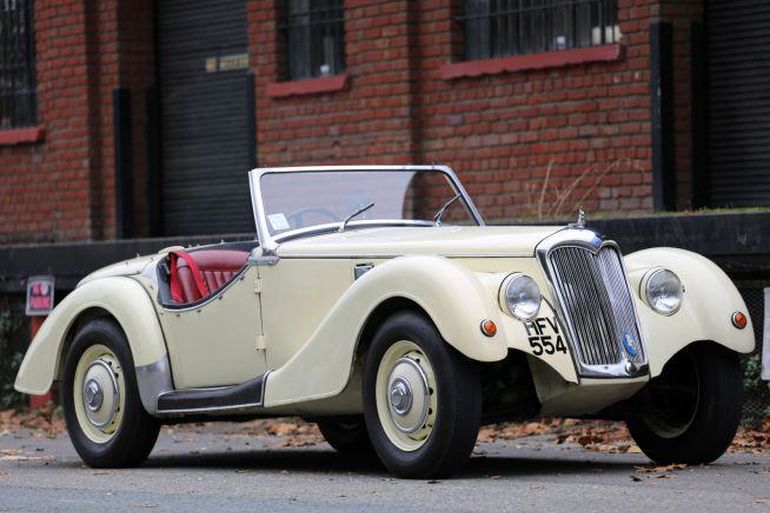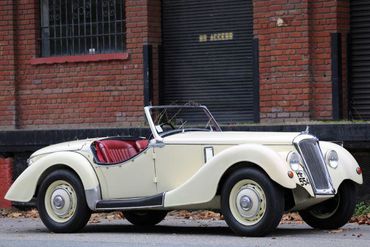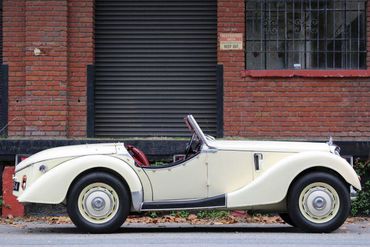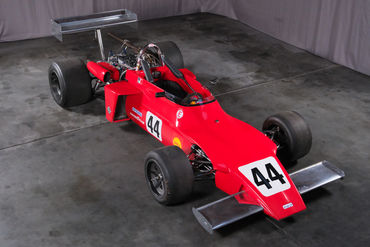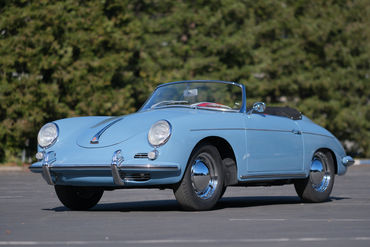Sold
SOLD 03/18
1952 Riley
SP6 Roadster
One-Off Special Bodied RMB-Based Roadster. Rack and Pinion Steering and Twin Cams.
- VIN23426/9596
- Exterior ColorLight Yellow
- Interior ColorRed Leather
- Mileage99716 Miles
- Engine2.5 liter inline-4
- Engine no.RMB2/390
- Transmission4-speed manual
- StatusSold
- StockFJ2160
Description
1952 Riley SP6 “RMS” Special Roadster
s/n 23426/9596
Ivory with Red Interior
Among the earliest pioneers of automobile manufacturing, Riley Cars must be regarded as both survivors and innovators in automotive history. Born from the 1890s as a cycle company, Riley Cycle evolved into motorcycle development and by 1898 had begun dabbling in automobiles. By the mid 1920s, the company had established themselves with motoring specials for racing purposes and hill climbs, making significant inroads into performance arenas against formidable competitors. Through the 1930s Riley ultimately developed higher priced offerings of prestige and elegance, competing in the luxury segment. In 1969, the company ceased manufacturing automobiles as an early casualty of British Leyland Motors consolidation. Today Riley cars are regarded highly for their unique design, technically robust mechanicals, and rarity, particularly in the US where few examples are found even at premier automotive events.
This particular Riley is a one of a kind coachbuilt roadster constructed by Riley expert Dennis Ramsay, a clever Scottish Motor engineer with a very specific goal in mind. Ramsey’s vision was to design and engineer a car that Riley should have produced as part of their RM range of models. Ramsay began to work in earnest on the project in the early 1980s when he purchased two RM saloons. Engineering began by first shortening the chassis a full two feet, designing a softer type underslung suspension at the rear (leaf springs with lever-type dampeners above the frame). The 95 inch wheelbase was short but effective for a two seat roadster package. Using crossmember construction to fortify the mid section, the frame was both rigid and lightweight, incorporating several lightening methods and box construction for rigidity. Adjustable Armstrong dampeners were installed at the front, with lower independent wishbones. The robust 2.5 liter engine was moved back 3” toward the cowl and Girling hydraulic brakes installed.
A talented and capable fabricator, Ramsay reviewed designs inspired by the BMW 328 and other prewar cars, in an effort to continue the Riley line established by the Imp, Sprite, and MPH, which never materialized as post war iterations. Ramsay then penned the initial by hand, performing all fabrication of the aluminum coachwork, making refinements as the project developed. A Riley grille was used but lowered 1.5”, and slightly raked. At the firewall, boxed steel door pillars were installed, cross-bracing the structure and stiffening the cowl. Rear saloon doors were cut down and fit to the new mid section. The front and rear fenders were modified to fit the overall design with the greatest changes made to the rear fenders, tapering into the distinctive boat tail design. The rear fenders featured dual fuel fillers, supplying a 12.5 gallon tank. The final exterior touch was an MG windscreen, low profile, but tall enough to capture a nice roofline when the top was in place. Ramsay owned the car only briefly before completing it, selling it to the first owner, an enthusiast in Crewe. The car was then sold to a series of owners through the 1990s and early 2000s, eventually (in 2016) finding its way to the current owner; well-known automotive enthusiast, writer, and historian Karl Ludvigsen.
Today the car presents with older paint and preserved cosmetics still suitable for driving enjoyment. The paintwork is glossy and presentable, with no major flaws, though exhibiting aging, minor flaws, and settling. The Ivory body color subtly conveys the fluid body lines with matching painted wheels and chrome-trimmed wheel covers. The body is straight and solid with good gaps and panel operation throughout all opening surfaces. The exterior chrome is in presentable condition and properly fit to the body, showing good luster due to proper care, but with evidence of age. The overall visual impression is sound and complete given the use the car has seen over the past three decades.
The interior is in similar condition to the exterior, with a satisfying and authentic finish to the surfaces, piping, and trim, all of which are showing signs of age, but not abuse. Carpets and door trim are in serviceable condition showing variations in color and typical wear points, which boast of the enjoyable use the car has seen. Unlike pampered show cars, the interior reveals the look and feel of a reliable, handsome artifact, composed and settled with an authenticity beguiling the more current period of construction. The dashboard is in very good shape, offering a nice array of original style instruments and accessories. The interior side panels and trim are all consistent with the rest of the car – tidy and cozy, displaying a charming English cabin flavor with a natural feel and inviting patina.
The engine compartment features the 2.5 liter engine with purposeful integrity, unabashedly honest in finish and preparation. Evidence of thoughtful engineering and mechanical facility during construction are shown in the cowl construction, inner fender workmanship, and hood. The boat tail trunk is most interesting featuring a sliding round medallion that cleverly conceals the latch. By easily moving the latch to the right, a double lever releases the boot and the large hand-formed aluminum deck lid is easily opened, revealing space for items, top and side curtains, and the twin filler fuel tank. The underside of the car is almost fully covered with hand formed belly pans, cut to allow suspension travel and access to fittings, but otherwise smartly done for improved aerodynamics.
The car runs and drives remarkably well. The engine has far more power and torque than one might imagine in a small car, giving smooth power delivery well into the higher revs. The gearbox is easily operated, with a slight bit of shudder taking up in first gear. The chassis and suspension have been properly sorted, again with surprisingly good braking and rather nice cornering capability. The nicely weighted steering, strong brakes, and independent front suspension truly balance the ride. There is no cowl shake or shudder in the body or frame – a significant boast to the capability of the builder, not only as a body designer, but engineer as well. In all the overall driving experience and pleasure in this car is very suitable for both casual touring, and potential events.
This is a great opportunity to acquire a nicely-sorted, genuine, one of a kind coachbuilt car with handmade aluminum construction, capable engineering, all embodied in a storied patina. This SP6 RMS Special Roadster beckons the new owner to drive and enjoy it as intended, just as Dennis Ramsay conceived of and built the car; fulfilling an honorable and rightful place in Riley Automobile history.
The above vehicle information is complete and accurate to the best of our knowledge at the time it is posted to this website. Corrections or additional information is always appreciated. All advertised prices exclude government fees and taxes, any finance charges, any dealer document preparation charge, and any emission testing charge. Vehicles are subject to prior sale. All advertised to be true but not guaranteed. We assume no liability for errors or omissions.
Inquire About This Car
Fantasy Junction • 510-653-7555 • 1145 Park Ave, Emeryville, CA 94608
